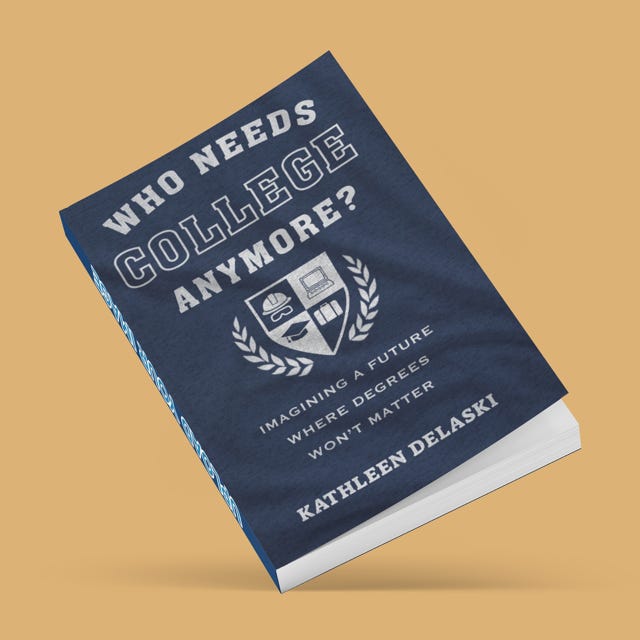The future of college, with Kathleen deLaski.
Plus, the House Appropriations Committee meets today on a bill gutting workforce.
Even if The Academy doesn’t always consider itself to be “workforce development,” American colleges soon will be forced to think a bit more like workforce programs.
Congress and the Trump Administration installed new jobs-based requirements on federal financial aid amid gutting that funding and freezing or ending other funding sources for universities. Colleges already faced a fuzzy financial future due to America’s declining numbers of college-aged young people and declining confidence in the value of a four-year degree.
To help me understand where college might go next, I chatted a couple weeks ago with Kathleen deLaski. Earlier this year, she published Who Needs College, Anymore?—a great book dissecting this moment of dissatisfaction and change in higher ed, the boot-camp era of training, and ways to build education and workforce that is more about skills and experience and less about degrees.
Kathleen, a former White House correspondent for ABC News, founded the Education Design Lab in 2013 and sits on its board and the board of Credential Engine. She also is a senior advisor to The Project on Workforce at Harvard University.
Below, Kathleen and I talk about the pressures placed on universities by those new employment-related requirements of federal financial aid, employers considering whether they want the “baggage” new graduates bring with them, and what needs to happen for these new models of higher education to go into effect.
This interview has been edited for length and clarity.

Nick: So, the book's been out in the wild for a little while now, and college is also on fire because of grant cuts and financial aid changes and a whole mess of other things. I don't think that's what you meant by “Who needs college anymore?”—but it's sort of the environment we're in.
Is this the right environment to try some of these more skills-focused approaches, or is change going to have to happen anyways?
Kathleen deLaski: Well, I think people fall into two camps. If you’re someone driven by concern and maybe fear of what happens to the model of the four-year degree, what happens to liberal arts colleges, your attitude may be “Batten down the hatches.” When I've done book talks, it's actually changed over the winter and spring based on what's most in the news. In some environments, I'm getting a reaction to the book that is, “This is the moment that we need to circle the wagons and make the case of why people need, the value of the degree and make the case for the liberal arts tradition.”
That's one camp. Then there's another camp, which is, you know, “Never waste a good crisis.” While certainly nobody's happy about what's happening, it's sort of, “How do we find opportunity amid crisis?” Those are probably the folks that are more interested [in the book] and inviting me to come to their campuses and talk about what are the levers for change—and how do we think about a stepladder approach to to college because that's sort of the main thesis of the book.
I'm framing my talks and my discussions with colleges as a “Yes and…” approach. Not, “You've got to throw out the baby with the bathwater,” but that degrees are an excellent tradition that many students will still seek and earn and and it will be their doorway to success. But many other students will choose a patchwork—or what I call a stepladder approach—to earning their skills to gain the value of what has traditionally been a linear four-year process.
We're just going to see many more pathways, and colleges need to embrace that in my view and be the offerer of different modalities and work-based opportunities.
Nick Beadle: So it's like diversifying your product catalog if you will. You don't just have hamburgers, you have a chicken sandwich. That sort of approach to college.
Kathleen: Exactly. And you know, the hard part is both the funding environment and the structural environment of colleges don’t really support a mixed set of offerings.
They support the degree—the four-year degree—and a four-year degree that isn't required to demonstrate specific outcomes for its graduates. Perhaps the biggest change in the environment since I finished the book in terms of the structure is the kind of tracking that colleges will be required to do [for federal financial aid] to demonstrate the value of a given major at the program level. It's very difficult. I'm sympathetic as to how difficult that's going to be.
There are anecdotal situations already demonstrating that some colleges are shutting down their psychology department, or thinking about, “What's the credential of value that could get them a job when they finish, immediately, as opposed to having to go on to a master's or a PhD?” These are the kinds of decision points that universities at the program level are now faced with. I think that understandably creates a lot of tension.
Nick: You mentioned the structural environment being very different, and Workforce Pell has a lot of new structures there that aren't necessarily built for college. But also because of that last-minute legislative deal, I feel like there's more opportunity for I think what you call stepladder and what I've called “small-plates college” that takes apart the degree. What changes do you think we need to mobilize schools toward that or just make it easier to tap into that money?
Kathleen: It looks like some of the action deciding what will count for Workforce Pell will be at the state level. States would be able to determine what credentials of value are earned through short-term programs that qualify for short-term Pell.
Obviously the guidance is being written now, and we don't have all the answers yet, but “portable” and “stackable” is something described in the legislation. “Portable” means that you could take those credits with you to another college, and “stackable” means that the learner needs to have visibility into how a short-term program could be stacked to another short-term program and eventually add up to a degree.
I know that's something that the Education Design Lab, where I was for many years, is helping colleges visualize for their learners and for employers to show if you start out on a behavioral health track, what's that job? What's the job and the salary that you can get after an eight-week program? What's the job and salary you can get after a second add-on? What are then the different paths you might take to go in one direction? Towards being a therapist or another direction towards being a clinical administrator?
This is the kind of visibility that people have never had. I think that's going to be a good thing. And I think once pathways are clearer to learners and colleges—and for that matter, employers—I think it's a new game.
“I don't blame the students for being entitled. If you spent $200,000 getting a degree, you should feel entitled, right? But the problem is we're not focusing that time and money on really preparing people for the kind of roles [they will get hired into].”
Nick: The employer side of that has always been the big question to me. Something I've been doing for my own work is trying to figure out if there is a common language that we could be using with employers. I feel like most employers I talk to think their jobs are very, very particularized to them, even if there's a lot more in common between them and their competitors—or even very different job types.
What is the type of thing that we need to move employers and get them to have more uptake of these ideas and skills-first hiring? Is there some other proof of concept that we need to get them to move into this world and more fully adopt these ideas?
Kathleen: Well, I am a huge proponent of industries getting together and creating more of the industry-recognized credentials that relate to specific job roles. These exist in certain industries and I highlight these in the book. CompTIA is probably the best example of a third-party organization that has tried to work across employers to create a universal approach. If you have the network plus certification you could work at any data center [as] an entry-level data security manager, for example. Why can't we have that in more professions?
Why can't we have those in business and marketing and consulting or other professions? Because exactly to your point, every employer can't be a snowflake and want something different. Obviously, employers have their specific needs, but if we could credential-ize or certification-ize more job roles, I think this would really help. I look to industry associations to do that.
Nick: One of the more interesting concepts in your book—or at least one of the ones that made me go, "Huh”—is this idea that employers are rethinking hiring college graduates because they come with too much “baggage”—that they’re figuring a lot of things out. Now for college graduates, we have AI impacts on entry-level jobs—you kind of have Chekov’s Robot lingering here on the table.
How do you think colleges trying to evolve could impact that sort of baggage? Quite frankly, if you are that entry-level person how do you prove that you don't have enough baggage and you're worth considering over a robot?
Kathleen: Well, I first want to say that I think that the “baggage” that employers talk about is mostly a sense of entitlement. That's the main baggage they're thinking about. That [students] have spent all this money and they arrive and they want a pretty good job. [But] the people I interviewed, the employers we’re talking about [say] that the students show up with a very generalized degree, no experience, and high expectations.
I don't blame the students for being entitled. If you spent $200,000 getting a degree, you should feel entitled, right? But the problem is we're not focusing that time and money on really preparing people for the kind of roles [they will get hired into].
So to answer your question, what could [students] do differently, particularly in the age of AI, where at least some knowledge work entry-level jobs are said to be going away? I kind of answer that in one word, which is “experience.” I spend a whole chapter in the book describing how colleges are beginning to wrestle with that. “Maybe it should be our job to help students get experience in their field before we send them on their way.” Which is not currently the case.
Nick: You talk in the book about a vision of “skills wallets” where workers pick up pieces as they go along. I read the book thinking about how I’d try to make that work if I was still in government. What's government's role here? Do they need to be the validators here? Because I feel like employers are going to want someone validating workers’ skills.
Kathleen: It's a really good question. We see some of the early innovation in this in the skills wallet area happening at the state level and it is usually very entrepreneurial-minded people inside state governments who are doing this work.
I profiled North Dakota, which was doing interesting things. Alabama, your state, was doing interesting things with the [Alabama Talent Triad]. On the flip side, a lot of the funding for wallet applications are coming from big universities like Arizona State University or even some third-party groups that are commercial.
Nick: The Trump workforce blueprint talked about one of the reasons they want to blob together a lot of these programs is they want a common data set. So it sounds like they're kind of thinking about skills wallets, but they don't think they necessarily have the authority to do it just yet.
Kathleen: I mean, that's a concern. But I'm thinking you would be better to brainstorm about whether you could work off of data sets that exist. I think about groups like National Student Clearinghouse or Credential Engine, which I'm on the board of. So, you know, that's a self-serving statement, but there are some nonprofits that could take on a mission supported by government to be the clearinghouses or the intermediaries here. But it would take a government investment for sure.
Nick: Yeah, definitely. To close out, if I am a student in, let's say, the fall of 2027, and all these changes have gone into effect, do you think that, as a matter of necessity, we are going to have this more diversified set of options from colleges? Or do you think that it's probably going to take a little bit more time to cook?
Kathleen: I think it will definitely take more time. I don't think that in the fall of ‘27 or ‘26 a student is going to notice much difference in the offerings, particularly at a four-year college.
The Education Design Lab is already working with 130 community colleges to create these micro-pathways, but they're starting with six or seven micro-pathways. It's not like the course catalog is full of them. Obviously, certificates are the fastest-growing form of college enrollment, so I think that will kind of creep up on us and we'll see that.
But for the average student, I think it's going to be five to 10 years before there's a robust offering with efficacy data to back it up. Because it's going to take colleges that long to get the data, which does not exist for the short-term programs right now.
A quick workforce appropriations update.
Today is the next checkpoint for a House bill that would at least halve most of America’s workforce training. The full House Appropriations Committee will mark up the bill at the Rayburn Building at 11 a.m. You can watch live below:
I’ll be on a plane so I probably won’t have a ton of live reaction, but I’ll send out updates as needed this week. I saw some understandably grim reactions to this bill last week, but as has been a recurring point of discussion here in Michigan over the weekend, a similar bill didn’t survive last year.
Still, last year isn’t this year, where this money has had a cannon fired at it time after time since January 27. If you’re going to do any education and advocacy about a key source of funding—like, you know, the biggest dedicated pots of money for adult and youth workforce development—you probably ought to be doing it now to Republican members of the committee.
Card subject to change.
First, thanks to Kathleen for chatting. I hope you enjoyed today’s interview, which was a blast. I’m aiming to do one of these each month, and I have some really cool conversations in the works around the funding carnage.
Second, many thanks to Michigan Works! Association for having me at their annual conference and giving me an excuse to visit The Mitten, a state that I am happy to report continues to have excellent pizza and frozen treats and beer. Of which I would know nothing about, clearly.
Coming up: decent chance I show up in your inbox tomorrow or Thursday. The other big development is that more held-up grants funding keeps finding its way to the street with absurd application deadlines. I’m collecting these and may have a delightful post for you later this week. If we are blessed enough that nothing dramatic enough happens, I’ll be back to clean things up in THE MONEY on Friday, along with an update on the Ed-DOL merger and some of the grants funding changes at Ed.
Next Tuesday, calamity pending, I plan on writing about a flawed idea at the heart of efforts to cut American spending on workforce—and why I think some bad work by one of government’s key watchdogs is partially to blame.




